Related Research Articles
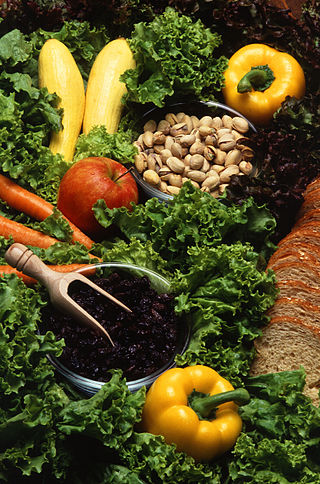
Vegetarian cuisine is based on food that meets vegetarian standards by not including meat and animal tissue products.

The peanut, also known as the groundnut, goober (US), pindar (US) or monkey nut (UK), is a legume crop grown mainly for its edible seeds. It is widely grown in the tropics and subtropics, important to both small and large commercial producers. It is classified as both a grain legume and, due to its high oil content, an oil crop. World annual production of shelled peanuts was 44 million tonnes in 2016, led by China with 38% of the world total. Atypically among legume crop plants, peanut pods develop underground (geocarpy) rather than above ground. With this characteristic in mind, the botanist Carl Linnaeus gave peanuts the specific epithet hypogaea, which means "under the earth".

A food pyramid is a representation of the optimal number of servings to be eaten each day from each of the basic food groups. The first pyramid was published in Sweden in 1974. The 1992 pyramid introduced by the United States Department of Agriculture (USDA) was called the "Food Guide Pyramid" or "Eating Right Pyramid". It was updated in 2005 to "MyPyramid", and then it was replaced by "MyPlate" in 2011.

A nut is a fruit consisting of a hard or tough nutshell protecting a kernel which is usually edible. In general usage and in a culinary sense, a wide variety of dry seeds are called nuts, but in a botanical context "nut" implies that the shell does not open to release the seed (indehiscent).

A meat alternative or meat substitute is a food product made from vegetarian or vegan ingredients, eaten as a replacement for meat. Meat alternatives typically approximate qualities of specific types of meat, such as mouthfeel, flavor, appearance, or chemical characteristics. Plant- and fungus-based substitutes are frequently made with soy, but may also be made from wheat gluten as in seitan, pea protein as in the Beyond Burger, or mycoprotein as in Quorn.

Vigna subterranea is a member of the family Fabaceae. Its name is derived from the Bambara tribe. The plant originated in West Africa. As a food and source of income, the Bambara groundnut is considered to be the third most important leguminous crop in those African countries where it is grown, after peanut and cowpea. The crop is mainly cultivated, sold and processed by women, and is, thus, particularly valuable for female subsistence farmers.

Almond milk is a plant-based milk substitute with a watery texture and nutty flavor manufactured from almonds, although some types or brands are flavored in imitation of cow's milk. It does not contain cholesterol or lactose and is low in saturated fat. Almond milk is often consumed by those who are lactose-intolerant and others, such as vegans, who avoid dairy products. Commercial almond milk comes in sweetened, unsweetened, vanilla and chocolate flavors, and is usually fortified with micronutrients. It can also be made at home using a blender, almonds and water.

Vegetarian nutrition is the set of health-related challenges and advantages of vegetarian diets.

Therapeutic foods are foods designed for specific, usually nutritional, therapeutic purposes as a form of dietary supplement. The primary examples of therapeutic foods are used for emergency feeding of malnourished children or to supplement the diets of persons with special nutrition requirements, such as the elderly.
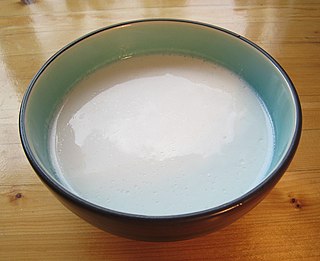
Plant milk is a plant beverage with a color resembling that of milk. Plant milks are non-dairy beverages made from a water-based plant extract for flavoring and aroma. Plant milks are consumed as alternatives to dairy milk, and may provide a creamy mouthfeel.

A milk substitute is any substance that resembles milk and can be used in the same ways as milk. Such substances may be variously known as non-dairy beverage, nut milk, grain milk, legume milk, mock milk and alternative milk.
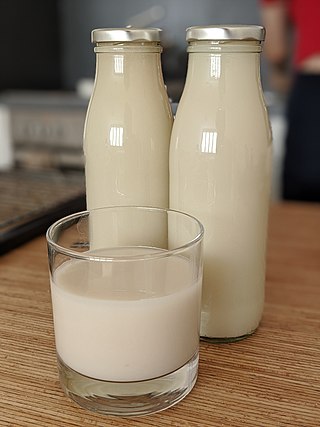
Oat milk is a plant milk derived from whole oat grains by extracting the plant material with water. Oat milk has a creamy texture and mild oatmeal-like flavor, and is manufactured in various flavors, such as sweetened, unsweetened, vanilla, and chocolate.
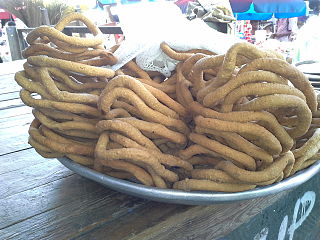
Kuli-kuli is a West African snack primarily made from peanuts, first made by the various ethnic groups including the Nupe people of Nigeria and Dagbon people of Ghana. It is a popular snack in Nigeria, Benin, northern Cameroon and Ghana. It is often eaten alone or with a mixture of garri also known as cassava flakes, sugar and water, popularly called "garri soakings". It is also eaten with Hausa koko, fura, and kamu, and is sometimes ground and put into salad. It is often ground and used as an ingredient for suya and kilishi.

Plant cream is an imitation of dairy cream made without dairy products, and thus vegan. It is typically produced by grinding plant material into a thick liquid to which gums are added to imitate the viscosity and mouthfeel of cream. Common varieties are soy cream, coconut cream, and cashew cream. It is used as a dessert topping and in many other dishes and beverages.
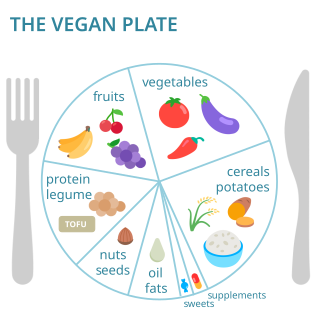
Vegan nutrition refers to the nutritional and human health aspects of vegan diets. A well-planned, balanced vegan diet is suitable to meet all recommendations for nutrients in every stage of human life. Vegan diets tend to be higher in dietary fiber, magnesium, folic acid, vitamin C, vitamin E, iron, and phytochemicals; and lower in calories, saturated fat, cholesterol, long-chain omega-3 fatty acids, vitamin D, calcium, zinc, and vitamin B12.
The history of USDA nutrition guidelines includes over 100 years of nutrition advice promulgated by the USDA. The guidelines have been updated over time, to adopt new scientific findings and new public health marketing techniques. The current guidelines are the Dietary Guidelines for Americans 2015–2020. been criticized as not accurately representing scientific information about optimal nutrition, and as being overly influenced by the agricultural industries the USDA promotes.
Citadel Spread is a paste made of peanut butter, oil, sugar and milk powder. First developed as a trail food for hikers, a Citadel Spread resembles common ready-to-use therapeutic food (RUTF) formulations, such as Plumpy'nut.

Vegan cheese is a category of non-dairy, plant-based cheese analogues. Vegan cheeses range from soft fresh cheeses to aged and cultured hard grateable cheeses like plant-based Parmesan. The defining characteristic of vegan cheese is the exclusion of all animal products.

Elmhurst 1925 is a plant-based food and beverage company located in Elma, New York. The company manufactures and sells non-dairy, plant-based milks made from nuts, grains, and seeds. The first four nutmilks – almond, cashew, hazelnut, and walnut – debuted at Natural Products Expo West in March 2017. A number of additional products have launched since, including their line of unsweetened plant milks made with only two or three ingredients, award winning barista editions, dairy-free creamers, and single serve ready-to-drink options.
References
- ↑ "Peanut Milk Benefits". LIVESTRONG.COM. Retrieved 2022-02-12.
- ↑ "Vitamin E". Linus Pauling Institute. 2014-04-22. Retrieved 2022-02-12.
- ↑ "Vitamin B6". Linus Pauling Institute. 2014-04-22. Retrieved 2022-02-12.
- ↑ quadri, zainab (2016-12-19). "Here is how to make Groundnut milk, a vegan alternative to cow milk". Pulse Nigeria. Retrieved 2022-07-02.
- ↑ "George Washington Carver: A World-Famous Scientist, Inventor and Educator | National Peanut Board". nationalpeanutboard.org. Retrieved 2022-02-13.
- ↑ Gray, LaVerne (2011-06-14). "The George Washington Carver Digital Collection2011243The George Washington Carver Digital Collection. URL: www.lib.iastate.edu/spcl/gwc/home.html: Iowa State University Last visited February 2011. Gratis". Reference Reviews. 25 (5): 60. doi:10.1108/09504121111145591. ISSN 0950-4125.
- ↑ "Retail Sales Data". Plant Based Foods Association. Retrieved 2022-02-12.
- ↑ "Retail sales data: Plant-based meat, eggs, dairy | GFI". gfi.org. 2021-01-19. Retrieved 2022-02-13.
- 1 2 "DIY Peanut Milk | National Peanut Board". nationalpeanutboard.org. Retrieved 2022-02-13.
- ↑ quadri, zainab (2016-12-30). "This Groundnut Milk and Rice Gruel combo is the best recipe on the Internet right now". Pulse Nigeria. Retrieved 2022-07-02.
- ↑ "Peanut milk". ResearchGate.
- ↑ "Peanut Profile". www.agmrc.org. Retrieved 2022-02-13.
- 1 2 "Peanuts are the Food of the Future. Here's why. | National Peanut Board". nationalpeanutboard.org. Retrieved 2022-02-13.
- 1 2 "New Data Confirms Peanuts are More Water Efficient Than Ever | National Peanut Board". nationalpeanutboard.org. Retrieved 2022-02-13.
- ↑ "How Eco-Friendly Are Nuts? | Which is the Most Eco-Friendly Nut?". Green Eco Friend. 2020-12-21. Retrieved 2022-02-13.
- ↑ Kane, Nimsate; Ahmedna, Mohamed; Yu, Jianmei (2010). "Development of a fortified peanut‐based infant formula for recovery of severely malnourished children". International Journal of Food Science and Technology. 45 (10): 1965–1972. doi:10.1111/j.1365-2621.2010.02330.x.
- ↑ Chalupa-Krebzdak, Sebastian; Long, Chloe J.; Bohrer, Benjamin M. (December 2018). "Nutrient density and nutritional value of milk and plant-based milk alternatives". International Dairy Journal. 87: 84–92. doi:10.1016/j.idairyj.2018.07.018. S2CID 91497320.